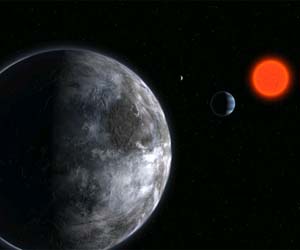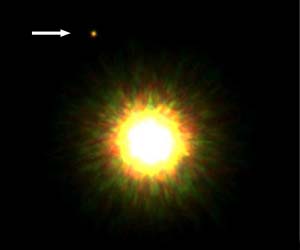|
|
Exoplanets
Facts and Information
-
 Gliese 581 d was the first exoplanet discovered known to orbit in the habitable zone.
Gliese 581 d was the first exoplanet discovered known to orbit in the habitable zone.
-
 Exoplanet Corot-7b orbits so close to its parent star that its surface has turned into molten lava.
Exoplanet Corot-7b orbits so close to its parent star that its surface has turned into molten lava.
Exoplanet Facts
- Exoplanets also known as extrasolar planets, are planets which exist outside our solar system.
- As of 17th September 2011, 684 exoplanets have been discovered.
- In 1992 two planets orbiting the pulsar PSR 1257+12 became the first exoplanets to be detected.
- In 1995 51 Pegasi B was the first exoplanet to be discovered orbiting a sun like star.
- CD-35 2722 b is the most massive exoplanet to be found, it has 31 times the mass of Jupiter.
- Gliese 581 e is the least massive exoplanet detected orbiting a normal star, it has only around twice the mass of Earth.
- The habitable zone, also known as the 'Goldilocks Zone' is an area around a star which is at just the right temperature to allow liquid water to exist on an Earth like planet.
- Several possible Earth size planets have been detected orbiting in the habitable zone of stars although as yet none have been confirmed.
- Small Earth like planets could exist around our nearest stellar neighbor Proxima Centauri.
Exoplanets - The Search for Life
Kepler 11 has 6 orbiting planets, the largest exo-planetary system yet discovered.
Are we alone in the Universe? This is a question mankind has pondered for centuries, but only now do we have the technology to begin to answer that age old question.
The search is truly on to find another Earth like world but as yet we're still the only known planet in the Universe where life exists.
New evidence being compiled suggests that its highly unlikely that Earth is unique, it is estimated there are habitable planets around 10 to 20% of the stars in our galaxy.
When you consider that there are 200 billion stars in the Milky Way then it could possibly contain billions of worlds similar to our own. The problem with Earth like planets
is that they're very small, making them extremely difficult to detect, even so scientists are predicting that its only a matter of time before one is discovered
somewhere in our galaxy.
Types of Exoplanets
Gas Giants

Hot Jupiters

Super Earths

Free Floating Planets

Pulsar Planets

Ocean Worlds

Chthonian Planets

Exo Earths

Searching for Exoplanets
Doppler Spectroscopy
Stellar Nurseries
Selected Exoplanet Stats
Name: TrES-2 b
Mass: 1.28 Jupiters
Distance from star: 3.7 million miles (5.95 million km)
Orbit: 2.5 days
Distance from Earth: 500 light years
Due to the very close orbit of its parent star TrES-2 b is a very hot world, but as a result of reflecting less than 1 percent of the sunlight it receives it is darker than coal. Making it the darkest planet ever discovered.
Mass: 1.28 Jupiters
Distance from star: 3.7 million miles (5.95 million km)
Orbit: 2.5 days
Distance from Earth: 500 light years
Due to the very close orbit of its parent star TrES-2 b is a very hot world, but as a result of reflecting less than 1 percent of the sunlight it receives it is darker than coal. Making it the darkest planet ever discovered.
Name:1RSX-J1609 b
Mass: 8 Jupiters
Distance from star: 30 billion miles (48 billion km)
Orbit: Unknown
Distance from Earth: 471 light years
The small dot on the image below is the first ever direct image of a planet outside of our solar system. Due to the vast distance from its parent star it could take the planet over 1,000 years to make a complete orbit.
Mass: 8 Jupiters
Distance from star: 30 billion miles (48 billion km)
Orbit: Unknown
Distance from Earth: 471 light years
The small dot on the image below is the first ever direct image of a planet outside of our solar system. Due to the vast distance from its parent star it could take the planet over 1,000 years to make a complete orbit.

Name:Kepler-16b
Mass: 1 Jupiters
Distance from star: 65 million miles (105 million km)
Orbit: 226 days
Distance from Earth: 200 light years
Kepler-16b is the first planet to be discovered that orbits around 2 suns. Both the stars are smaller and significantly cooler than our Sun making Kepler-16b a very cold gas giant.
Mass: 1 Jupiters
Distance from star: 65 million miles (105 million km)
Orbit: 226 days
Distance from Earth: 200 light years
Kepler-16b is the first planet to be discovered that orbits around 2 suns. Both the stars are smaller and significantly cooler than our Sun making Kepler-16b a very cold gas giant.
Name: PSR B1620-26 b
Mass: 2.5 Jupiters
Distance from star: 2 billion miles (3.2 billion km)
Orbit: 100 years
Distance from Earth: 12,350 light years
PSR B1620-26 b also known as Methuselah is the oldest planet to be discovered. It is thought to have formed only a billion years after the big bang making it around 12.7 billion years old.
Mass: 2.5 Jupiters
Distance from star: 2 billion miles (3.2 billion km)
Orbit: 100 years
Distance from Earth: 12,350 light years
PSR B1620-26 b also known as Methuselah is the oldest planet to be discovered. It is thought to have formed only a billion years after the big bang making it around 12.7 billion years old.
Name: Gliese 876 b
Mass: 1.89 Jupiters
Distance from star: 20 million miles (32 million km)
Orbit: 61 days
Distance from Earth: 15 light years
Gliese 876 b was the first planet discovered orbiting a red dwarf star. More importantly this gas giant orbits in the habitable zone meaning any of its large moons could possibly support life.
Mass: 1.89 Jupiters
Distance from star: 20 million miles (32 million km)
Orbit: 61 days
Distance from Earth: 15 light years
Gliese 876 b was the first planet discovered orbiting a red dwarf star. More importantly this gas giant orbits in the habitable zone meaning any of its large moons could possibly support life.
Name: HD 85512 b
Mass: 3.6 Earths
Distance from star: 25 million miles (40 million km)
Orbit: 54 days
Distance from Earth: 36 light years
HD 85512 b is the smallest exoplanet discovered that orbits in the habitable zone. The temperature of its atmosphere is thought to be around 25C (77F) and the planet could possibly provide a habitable environment.
Mass: 3.6 Earths
Distance from star: 25 million miles (40 million km)
Orbit: 54 days
Distance from Earth: 36 light years
HD 85512 b is the smallest exoplanet discovered that orbits in the habitable zone. The temperature of its atmosphere is thought to be around 25C (77F) and the planet could possibly provide a habitable environment.